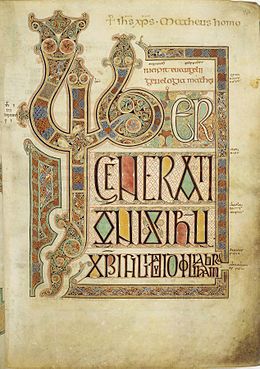
Back فن إنجليزي Arabic Celf Lloegr Welsh English School German Engleska umjetnost Croatian ಇಂಗ್ಲೆಂಡಿನ ಕಲೆ Kannada Англиска уметност Macedonian Английское искусство Russian Engleska umetnost Serbian

English art is the body of visual arts made in England. England has Europe's earliest and northernmost ice-age cave art.[1] Prehistoric art in England largely corresponds with art made elsewhere in contemporary Britain, but early medieval Anglo-Saxon art saw the development of a distinctly English style,[2] and English art continued thereafter to have a distinct character. English art made after the formation in 1707 of the Kingdom of Great Britain may be regarded in most respects simultaneously as art of the United Kingdom.
Medieval English painting, mainly religious, had a strong national tradition and was influential in Europe.[3] The English Reformation, which was antipathetic to art, not only brought this tradition to an abrupt stop but resulted in the destruction of almost all wall-paintings.[4][5] Only illuminated manuscripts now survive in good numbers.[6]
There is in the art of the English Renaissance a strong interest in portraiture, and the portrait miniature was more popular in England than anywhere else.[7] English Renaissance sculpture was mainly architectural and for monumental tombs.[8] English Gothic architecture and art flourished from the late 12th until the mid-17th century. Interest in English landscape painting had begun to develop by the time of the 1707 Act of Union.[9]
Substantive definitions of English art have been attempted by, among others, art scholar Nikolaus Pevsner (in his 1956 book The Englishness of English Art),[10] art historian Roy Strong (in his 2000 book The Spirit of Britain: A narrative history of the arts)[11] and critic Peter Ackroyd (in his 2002 book Albion).[12]
- ^ "Britain's first nude?". The Daily Telegraph. Retrieved 28 August 2017.
- ^ "Anglo-Saxon art". Encyclopædia Britannica. Retrieved 28 August 2017.
- ^ "Western Dark Ages And Medieval Christendom". Encyclopædia Britannica. Retrieved 28 August 2017.
- ^ "The story of the Reformation needs reforming". The Daily Telegraph. Archived from the original on 23 June 2012. Retrieved 11 September 2017.
- ^ "Art under Attack: Histories of British Iconoclasm". Tate. Retrieved 28 August 2017.
- ^ "Manuscripts from the 8th to the 15th century". British Library. Archived from the original on 30 March 2020. Retrieved 28 August 2017.
- ^ "Portrait Painting in England, 1600–1800". Metropolitan Museum of Art. Retrieved 28 August 2017.
- ^ "Medieval And Renaissance Sculpture". Ashmolean Museum. Archived from the original on 12 September 2017. Retrieved 28 August 2017.
- ^ "Edge of darkness". The Guardian. Retrieved 28 August 2017.
- ^ "Nikolaus Pevsner: The Englishness of English Art: 1955". BBC Online. Retrieved 30 August 2017.
- ^ "That was then..." The Guardian. Retrieved 30 August 2017.
- ^ "Ackroyd's England". The Daily Telegraph. Retrieved 30 August 2017.